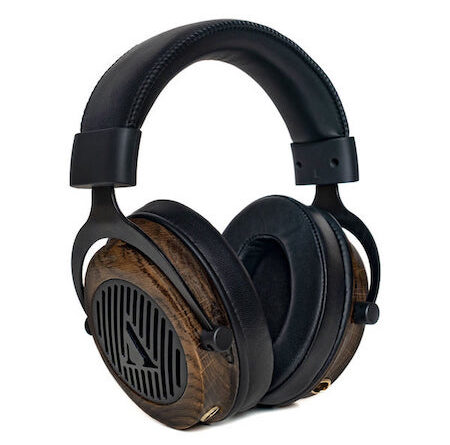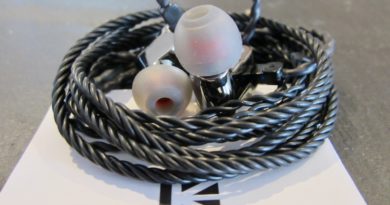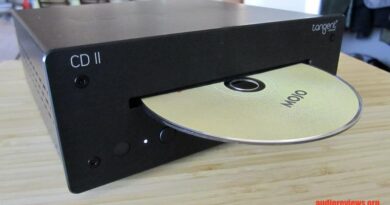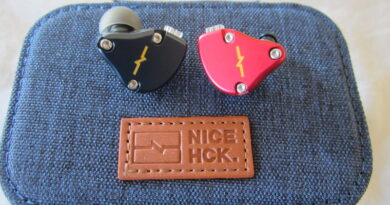APOS Caspian Headphone Review (1) – Another Music From a Different Kitchen
You could not have picked a worse time to promote a Russian-branded collaboration with Saint Petersburgh-based Kennerton (who loudly declare “No Politics Zone!” on their website), but I fully trust that the Caspian’s creators do not endorse strafing civilian evacuees or vacuum-bombing nuclear power plants and I accordingly approach the Caspian as a neutral observer.
The $500, open-backed Caspian arrive in a plain box with a nice leather carrying case and a garden hose-sized cloth-coated XLR to ¼” cable. Their aesthetics and design are a matter of taste — I thought the (real) oak ear cups might have looked more natural in a lighter color–but the stainless steel frame is very solid and these should last a lifetime or two.
The Caspian have some heft (13.3 oz) and considerable clamping force, but the sheepskin pads feel soft and pliable and I found these comfortable for extended listening sessions. (Note that Apos also included its balanced XLR Flow cable, which will be the subject of a separate review).
Listed at an efficient 33Ohm/128db, the Caspian get plenty loud with just a mobile or a dongle (you’ll need a ¼” to 3.5mm adapter, which was a curious omission), but gain crispness and richness when amped. My modest Aune T1 tube amp drives ‘em okay, but they really needed my buddy’s Chord Mojo to show their full potential, and I would not recommend running these without high-quality, higher powered amplification.
According to Apos, the Caspian’s designers sought to make a “fun-as-hell” phone that “didn’t ruin your favorite albums with merciless detail-retrieval.” Some pundits have thus branded the Caspian as “audiophile for beginners,” which is both partly true and somewhat dismissive, as if more sophisticated listeners all crave a highly resolving, flat tuning.
In any event, the Caspian achieves its stated goals—it immediately registers as a loud, rich-textured, unabashedly basshead phone. Low end is seismic, with a ton of emphasis in the upper bass (80-160 Hz) region. It is by no means articulate or taut bass, and decay is slow.
Depending upon source, the low end can sound bloated and/or overdone—Jymie Merrit’s acoustic double bass on Art Blakey’s “Moanin” sounded more like an overamped electric, while the deep dub parts on the Clash’s “Sandanista” sounded borderline out-of-control. But, in fairness, never dull.
Soundstage on the Caspian is less expansive than expected—it’s deep but fairly low-ceilinged and within-your head. There’s adequate separation between performers, but a tendency on denser fare to bunch the performers towards the middle, and stereo imaging is less precise. Mids, however, are full bodied and have very good clarity, which keeps them from being overshadowed by the massive bass.
As advertised, the Caspian are not detail-monsters, and compared to most of its price peers there is some roll-off of the extreme high frequencies. However, most will find their level of resolution to be just fine—brass and reeds sound life-like while cymbals and hi hats have good snap.
Tonality is slightly warmer than neutral and has a juiced-up, amplified quality which works much better for rock than for subtler fare; the Caspian avoid stridency or coarseness and do well with lower-quality files.
Compared to something like the ($500ish) Hifiman Sundara planars, the Caspian have a narrower stage, less precise imaging and considerably less high-end extension. However, the Caspian were, by a wide margin, the more exciting, engaging listen, with a much weightier note texture—the Sundara sounded bass-shy, overanalytical and somewhat thin by contrast.
The Sennheiser HD600 is a closer match—the Senn is also technically superior and coherent throughout the spectrum, with more air between instruments and sparkle on top and much tighter (tho less impactful) bass which avoids the overbearing, electronic overhang of the Caspian’s.
However, after hearing the Caspian there’s something just a bit clinical and studio-monitorish about the Senn—at least on heavier fare its highs seem a bit overpixilated and lacking in body and warmth, while the darker Caspian were more opaque but also more musical.
I no longer have my ($450) Grado RS2e to compare, though from memory the Grado had the wider stage, imaged better and had more transparent, delicate highs, but were somewhat undercooked in the lower registers and lacked the sheer physicality of the Caspian.
So is the Caspian a good value? Well, paired with a suitable amp, they’re a well-built, high-octane alternative to the ubiquitous flat or Harman-tuned $500 cans. For me, even with my unrefined palate, their low end is just a bit too much—these coulda been a real contender if it had been dialed down a few dbs.
However, there is undoubtedly a big swath of listeners who crave just this sort of visceral thrill, and l hope the bombs stop falling long enough for these to continue to reach our shores.
Disclaimer: sent to me by Apos for an audition—I’ll be passing them on to the noted gangster rap aficionado Durwood for his unbiased opinion. We do not participate in Apos Audio’s affiliate program.
By the Caspian from Apos Audio.
Specifications Apos Caspian
- Driver: Graphene-coated multilayered composite
- Driver unit: 50mm
- Frequency response: 5-45,000Hz
- Sensitivity: 115dB
- Impedance: 33Ω
- Maximum input power: 500mW
- Ear cup outer material: Natural sheepskin leather
- Ear cup inner material: Acoustic memory foam
- Thickness of pads: 1” (27mm)
- External dimensions of pads: 4.5” x 3.4” (115mm x 88mm)
- Height and width of ear pad opening: 3” x 1.7” (77mm x 45mm)
- Grille material: aluminum alloy
- Headband materials: stainless steel, natural leather outer lining, bio-leather inner lining, polyurethane foam insert
- Yoke material: stainless steel
- Weight: 13.3oz (378g)
In the Box…
- Apos Caspian headphone
- Leather carrying bag
- Stock headphone cable (single-ended 6.35mm termination)







